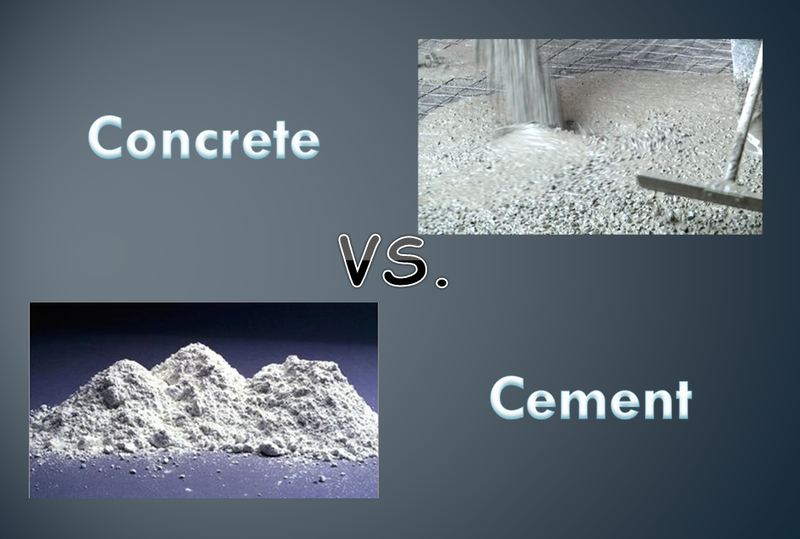Despite hearing the words concrete and cement on a regular basis, most people are not familiar with the differences between these two materials. Everyday people hear about the fluctuating prices of these commodities or their use in plans for home additions. In reality, however, there is a significant difference between concrete and cement, both in terms of their makeup and their common uses. In one word, the main difference of concrete and cement is that concrete is actually made up of aggregate, water, and cement.
To effectively compare concrete with cement, it helps to look at the two substances from a variety of perspectives as doing so will make the differences clearer.

Concrete vs. Cement: Historical Aspects
Concrete
As far as experts know, the first concrete occurrence may have been around twelve million years ago. This was naturally-forming cement that was created from oil shale which was right next to limestone when the limestone bed burnt.
In terms of human use, we have been using concrete for at least several thousand years. We know that eight thousand years ago, the ancient Nabataea culture used materials very similar to concrete and you can still see some of the structures today. There are also concrete floors formed from pebbles and lime in the Tiryns, Greece royal palace (1400 - 1200 BC) as well as lime mortars in Cyprus, Crete, and Greece (800 BC). Other historic groups who used concrete included the Assyrians and Romans.
Cement
Comparing concrete with cement shows both have long histories as the early Mesopotamians used cement during the third millennium BC and they were also used later on in Egypt. The Ancient Macedonians and Roman engineers also used cement that was a combination of concrete. You can still see examples of this ancient use today in the Pantheon’s large dome in Rome. John Smeaton helped advance the methods of cement while constructing the third Eddystone Lighthouse. Later, James Parker’s “Roman cement” became popular as a type of natural cement that could set in five to fifteen minutes.
Concrete vs. Cement: Components
Concrete
There are multiple concrete varieties and each of these has a different proportion of the main ingredients in concrete. The three ingredients in concrete are aggregate, cement, and water. Aggregate is a group of large chunks such as crushed rocks and/or coarse gravel (granite or limestone) and sand (or other fine materials). The most common type of cement included in concrete is Portland cement, but it may also be slag cement, fly ash, or asphalt.
The water is added after combining the aggregate and cement. At this point, the cement takes on a semi-liquid form so workers can shape it. It then solidifies via hydration, in which the water and cement react, bonding the other components to each other.
It is also common to add chemical admixtures to change the properties of the concrete or its drying time. There are also reinforcements which can be added, frequently in the form of steel or other materials with strong tension. There are also mineral admixtures which are recycled materials aimed at making the concrete more environmentally friendly.
Cement
Today, the most common type of cement is Portland cement. This is produced by heating up limestone as well as small amounts of clay or other materials in a kiln. Then calcination causes quicklime to form, a component which then gets blended with other materials. This results in the creation of “clinker,” a hard substance which is ground together with gypsum to create “Ordinary Portland Cement”, a powder. This cement is most commonly used to create concrete.
You will also find energetically modified cement (EMC) which creates an alternative for Portland cement in the creation of concrete which is considered to be high-level. This type of cement costs less and improves durability as well as performance. It also reduces the emission of carbon dioxide as well as the amount of energy required.
Additionally, there are several different blends of Portland cement and these can be either made as inter-ground mixtures or be mixed from the ground components.
Concrete vs. Cement: Modern Use
Concrete
Concrete is a popular construction material that helps maintain the structure between rocks, bricks, and similar items. Because concrete has a lower tensile strength than cement, it isn’t used for cross tensions. This lower tensile strength also means that concrete is frequently reinforced with steel rods.
Despite the lower tensile strength, the inclusion of rocks in concrete tends to make it overall stronger than cement, allowing it to be used for materials that require extreme durability and strength. As such, you will frequently find it on roads, subways, pool edges, sidewalks, or even skyscrapers.
Cement
Like concrete, cement is commonly used to construct buildings. Portland cement is most commonly used and you can find it as a key component of bridges, dams, lighthouses, oil rigs, and more. When modern workers select a material, they must account for the fact that cement takes longer to set and the speed will depend on the quantity of gypsum in the mixture.
Today there are two types of cement in use: non-hydraulic and hydraulic. Hydraulic cement uses water in order to start the chemical reaction which hardens the mixture and this means that the fully formed product is water resistant. Hydraulic cement can even be hard underwater because the reaction is completely separate from the water within the cement mixture. Non-hydraulic cement is slightly less versatile today and it uses material which won’t harden if they are exposed to water. It cannot be used in wet environments, so you will never find it in bridges or underwater construction where you may find hydraulic cement.

View All Comments /Add Comment